|
"The types of projectile
breakage which occurred (during the Denver
elephant project) were found to
compare favorably with archaeological specimens"--------1982,
Bruce B. Huckell, "The Denver Elephant Project: A Report On
Experimentation With Thrusting Spears," Plains Anthropologist, Vol.
27, No. 97, August 1982, p. 217.
"Stone points of any
size or shape tend to break so easily that durability beyond a few uses
was probably not an achievable goal."--------2006,
Joseph Cheshier and Robert L. Kelly, "Projectile Point Shape And
Durability: The Effect Of Thickness, Length," American
Antiquity, Vol. 71, No. 2, p. 354.
"A seventh
rib from a seven-year-old individual (of
extinct bison antiquus) displays the
compression morphology of a projectile point impact on its lateral
surface. Fragments of the projectile's tip are lodged inside the impact
scar."------1999,
Leland C. Bement, "Bison Hunting At Cooper Site,"
p. 104.
"According to
some experimental results, flute-like fractures, burin-like fractures,
and bend break and burin-like fractures are typical of breakage caused
by using the point as a dart or thrusting spear tip"--------2009,
Jun Hashizume, "Paleoindian Projectile Point Breakage And Reshaping,"
Hell Gap, A Stratified Paleoindian Campsite At The Edge Of The
Rockies, p. 282.
"---most
fracture specimens (of Lake Mojave
points) resulted from bend force
breaking along weaknesses in the raw materials as well as cracks
produced during manufacture, but there were also examples of impact
fractures."--------2002,
Noel D. Justice, "Stone Age Spear And Arrow Points Of The
Southwestern United States," p. 97.
"Bending
fractures were most commonly located at the neck, and resulted from
impact on soft, yielding materials such as sod, but these breaks also
resulted from impact on harder, yielding materials such as loose gravel."----2006,
Gene L. Titmus and James C. Woods, "An Experimental Study Of
Projectile Point Fracture Patterns," Journal Of California And
Great Basin Anthropology, Vol. 8, No. 1, p. 43.
"Fractures resulting from impact on a hard,
unyielding surface such as a large boulder or an old, dried pine stump
produced another common break best described as crushing"---------2006,
Gene L. Titmus and James C. Woods, "An Experimental Study Of
Projectile Point Fracture Patterns," Journal Of California And
Great Basin Anthropology, Vol. 8, No. 1, p. 43.
"On
projectiles subjected to forces in-line with the long axis of the blade,
and in cases where the impacted materials were somewhat yielding, such
as live wood, the resulting fractures were primarily oriented
longitudinally in the form of what could be termed burinations"---------2006,
Gene L. Titmus and James C. Woods, "An Experimental Study Of
Projectile Point Fracture Patterns," Journal Of California And
Great Basin Anthropology, Vol. 8, No. 1, p. 45.
"Of the 34
points employed in this study, fractures occurred most commonly on first
throws, although a high survival rate was demonstrated on some specimens"---------2006,
Gene L. Titmus and James C. Woods, "An Experimental Study Of
Projectile Point Fracture Patterns," Journal Of California And
Great Basin Anthropology, Vol. 8, No. 1, p. 43.

CLICK ON PICTURE FOR LARGER IMAGE
MISCELLANEOUS PROJECTILE POINTS
WITH IMPACT FRACTURES
FLAKED STONE PROJECTILE POINT
IMPACT FRACTURES
Stone tools are often identified by their wear
patterns. Archaeologists refer to this area of study as "use wear
analysis." Some tools are more easily identified than others, especially those that were heavily used. Some examples of common
types of wear patterns, caused from use, are scraping, cutting, hammering, drilling, digging, abrading,
and piercing. Projectile points were designed specifically for piercing
and cutting. As a result, they are on the receiving end of what might be
called
"extreme wear."
They offer some of the most interesting types of
fracturing patterns. |
|
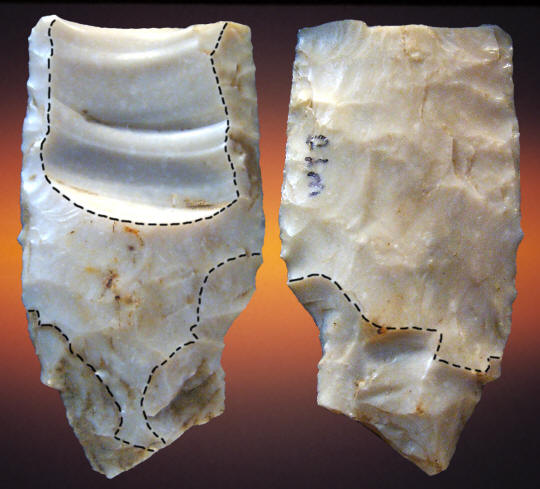
CLICK ON PICTURE FOR LARGER IMAGE
DALTON POINT WITH
"EXTREME"
IMPACT DAMAGE
MISSOURI
This Dalton point struck something
hard enough to completely destroy it. There was no chance of repair
by resharpening and rebasing. The tip of the point is shattered with
a crushing type of impact fracture that removed the tip and a
portion of both edges. The base was completely removed and a large
channel flake further damaged the point in a way that
might be described as a bend-hinge "flute" caused from backward
pressure against the haft. |
|
|
In recent decades there have been several
projectile point impact studies done for the purpose of acquiring
statistical data on fracture patterns. Some of the more dramatic
projects have used replicated Clovis tools and dead elephants as the
target. One of the earliest experiments involved an elephant from a zoo
in 1978. The experiment is known as the "The Denver Elephant Project," and was led by
Smithsonian archaeologist Dennis Stanford. Another project in 1984, was
led by University of Wyoming archaeologist George Frison and involved
dead elephants from an elephant culling operation in Zimbabwe, Africa.
Both of these experiments produced similar impact fractures as those
found on ancient sites. Frison wrote, "These experiments allow a number
of cautious observations on the manufacture, use, and effectiveness of
Clovis weaponry." The projects also provided data on bone fractures,
wood foreshaft breaks, butchering processes, projectile penetration
depths and edge-wear analysis. |
|
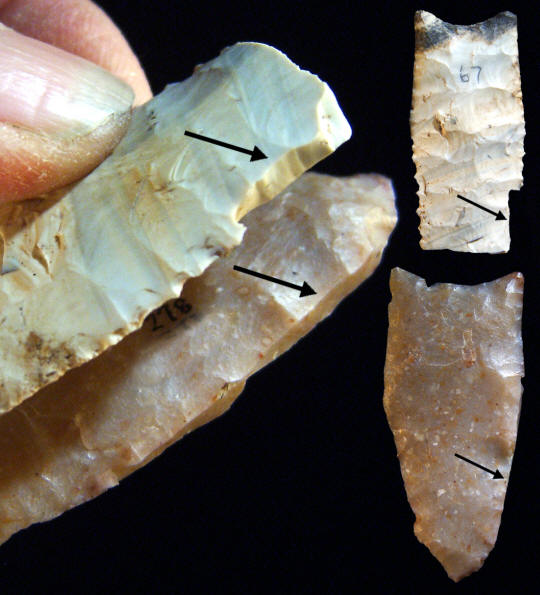
CLICK ON PICTURE FOR LARGER IMAGE
BURIN EDGE SHEARING FRACTURES
CLOVIS & DALTON POINTS
BOSTROM CLOVIS SITE, ILLINOIS & MISSOURI
Both of these early
projectile points have similar types of impact damage. The Dalton point
is missing the tip of its point from a cleanly snapped bend-break type
of impact fracture. A shearing fracture also caused a burin type of
flake removal on one edge. It's apparent that the Clovis point was
damage in some way and an attempt to resharpen it was made. It was
probably deliberately discarded on the camp site where it was found and
replaced with a newer point. One of the edges has a long burin type
fracture that is a good indication that this point may have received its
damage from impacting something hard---possibly the bone of an Ice Age animal. |
|
|
The earliest discovery of projectile point impact
damage on stone spear points comes from a site in the Kalahari Desert
called Kanthu Pan 1 in South Africa. The age of the site is still being
debated. The initial date of 500,000 years ago is extraordinarily early
since the next earliest date for stone projectile points is 250,000
years ago. But what is most interesting about the Kanthu Pan 1 points is
the fact that enough damaged examples were found to positively identify
them as projectile points. Further experiments with replicas of
Kanthu Pan 1 points also supports their use as projectile points. The
replicas were hafted and shot into Springbok carcasses resulting in
similar impact fractures as the ancient Kanthu Pan 1 points. |
|
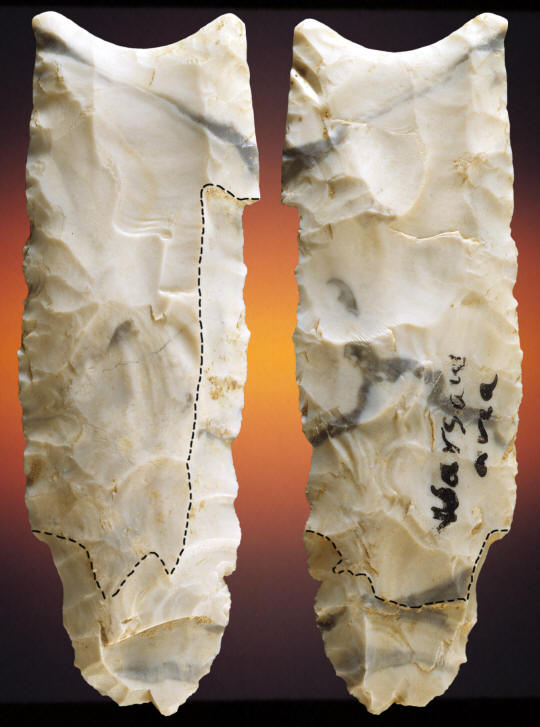
CLICK ON PICTURE FOR LARGER IMAGE
BURINATED EDGE & CRUSHING FRACTURES
DALTON POINT
MISSOURI
This Dalton point has major
impact damage that was caused by striking something hard such as bone,
antler, rock or wood. Its most impressive damage is a long burin type
flake removal that was sheared away from one edge. The tip of the point
also has extensive crushing type of step fractures. |
|
|
Three more examples of experimental point fracture studies
were published by Titmus and Woods, with atlatl darts, in 1986, Cheshier
and Kelly, with arrows, in 2006 and George Odell and Frank Cowan, with
arrows, in 1986. All three experiments recorded high rates of point
damage from impacts against different types of materials. The Titmus/Woods study used various types of stone, soil and wood materials
as their targets and the Cheshier/Kelly study used a dead white tail
deer for their target. |
|
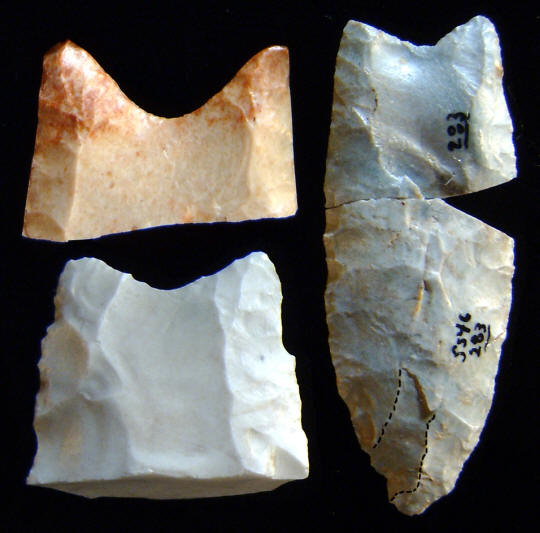
BEND-BREAK & FLUTE FRACTURES
CLOVIS POINTS
BOSTROM SITE & OHIO
These Clovis points all
seem to have damage that was caused by a use-wear type of impact
fracturing. The two on the left represent a more common type of impact
fracture called bend-break. Bend-breaks are fractures that are
perpendicular to the point's length. They appear as clean hinge snaps at
various locations, from the tip or distal end to the haft. The point on
the right also has this same type of bend-break fracture. It was found
in two pieces and the long narrow flake that was removed from one of the
tip edges seems to indicate where an impact strike was initially
located. The point at lower left was found in Ohio and the other two
were found on the Bostrom site in St. Clair County, Illinois. |
|
|
The Cheshier/Kelly arrow point impact study involved 50
arrows and produced an impact breakage rate of about 50% for first
impacts. Twelve of their points survived 2 shots, 8 points survived 3
shots, 6 points were shot 4 times and 3 points
survived 5, 6 and, 7 shots. The average number of attempts before a
point broke was 2.68. On-the-other-hand, the Titmus/Woods
study produced an impact breakage rate of 70% for first impacts. Twenty
one out of thirty experimentally thrown points broke on the first
attempt. The average number of attempts before a point broke was 2.1.
Seven of the points were thrown either 2, 3, 4 or 5 times before they
broke. One point was thrown 8 times and another was thrown 10 times. The
Odell/Cowan study produced the same impact fracture rate as the Cheshier/Kelly
study. Their average was 2.68 shots before the arrow point broke. |
|
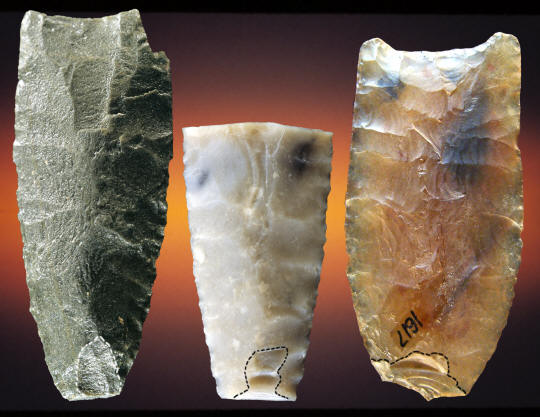
CRUSHING & BEND-HINGE
"FLUTE" FRACTURES
CLOVIS & GOSHEN POINTS
DOMEBO & MILL IRON SITES
OKLAHOMA & MONTANA
These three points appear
to have struck something hard. They all have tip damage that might be
identified as either crushing or bend-break type of fractures. The point
on the left also has a burin break that removed one ear. Its tip has
crushing and bend-hinge fractures. The center Clovis point was snapped
at its mid-section with a bend-break type of fracture and the tip seems
to have a bend-hinge "flute" type of impact damage. The tip of the
Goshen point on the right has a crushing type of impact fracture. The
two Clovis points on the left were found on the Domebo mammoth kill site
in Oklahoma and the Goshen point on the right was found on the mill Iron
site in Montana. |
|
|
Bradley (1982) identified use-damage and breaks as the two
main
categories of damage found on projectile points from the Agate Basin
site. Use-damage includes mainly impact damage. An example of break damage might
include a combination of use-damage and accidental damage, such as
trampling or it might be a manufacturing break caused by resharpening.
Bradley lists nine different subdivision types of projectile point break
damage in the Agate Basin study as bend, constrained bend, radial, outre passe,
perverse, radial bend, flaw, shear, and unknown. The different types of
use-damage, that is usually caused by impact, was identified as generalized impact, impact
burin, impact channel, and simple crushing. Use-damage on edges were
described as irregular, deep, and abrupt flake removals and damage to
the bases was identified as burin spall removals. |
|
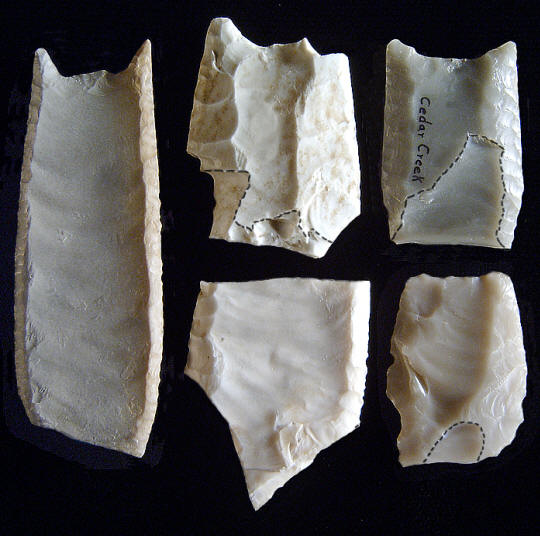
BEND-BREAK, BURIN & FLUTE
FRACTURES
FOLSOM POINTS
OKLAHOMA, TEXAS
All five of
these Folsom points were damaged from what appears to be use-wear
related impact fracturing. The point on the left was damaged from a
bend-break fracture. The point at lower center is missing its base from
a bend-break fracture and the tip (distal end) is missing from a
shearing fracture that burinated both edges. The point at top center is
missing one ear that snapped off from a bend-break fracture and the tip
is damaged from crushing fractures that sheared one edge with a burin
type fracture. The two points at right have damaged distal ends that
were caused by bend-hinge type impact fractures. |
|
|
The Titmus/Woods study describes three basic types of impact
fractures in the form of bending, crushing and shearing. The most common
type of break pattern is referred to as a bend break. These are
described as fractures that are perpendicular to the point's length.
They appear as clean hinge snaps at various locations, from the tip (distal end) to the haft. |
|

CLICK ON PICTURE FOR LARGER IMAGE
BEND-HINGE "FLUTES,"
CRUSHING &
SHEARING BURINATION FRACTURES
DALTON POINTS
MISSOURI
All three tips of these Dalton points have undergone obvious
use-wear impact fracturing. The point on the left has a bend break
type fracture that might be referred to as a bend-hinge "flute." The
point in the center has a large hinge termination type fracture that
was caused by a crushing type break pattern. The point on the right
was damaged from a crushing type of impact pattern that resulted in
the shearing of one edge with a burin type break and step fracturing
on the face. |
|
|
Crushing may be the second most common impact fracture. Crushing is
usually located at the distal (tip) end and caused from hitting a relative
hard surface, such as a bone. Crushing damage can occur at the tip and
also along the edges or margins. The fracture pattern appears as a
random mix of overlapping and heavily undulating flake removals that can
also have step fracturing at the point of impact. |
|
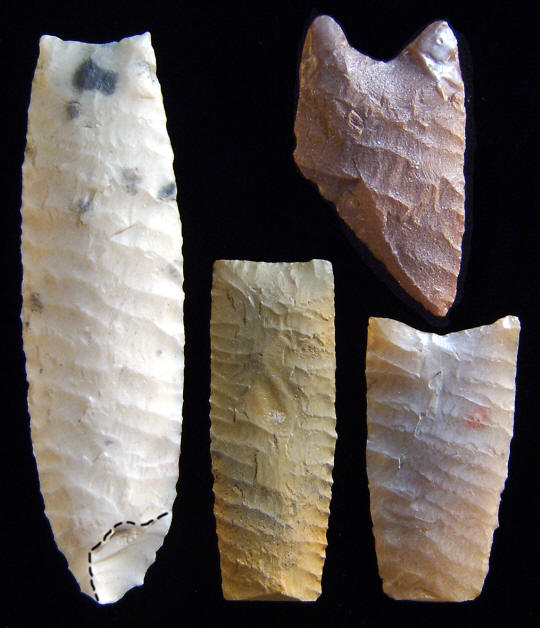
BEND-BREAK FRACTURES
ANGOSTURA POINTS
SOUTH DAKOTA
These four Angostura points
have missing tips from apparent use related impact damage. The damage on
the point on the left might be interpreted as a crushing fracture. The
other three points have simple bend break type impact fractures. |
|
|
A third and probably a less common form of projectile point
impact damage is shearing or burin fracturing. These are
longitudinal edge breaks that leave right angle fractures to both faces.
These types of fractures occur when the line of force is in-line with
the long axis of the projectile point. Burination is also a term that is
used to describe these types of breaks. |
|
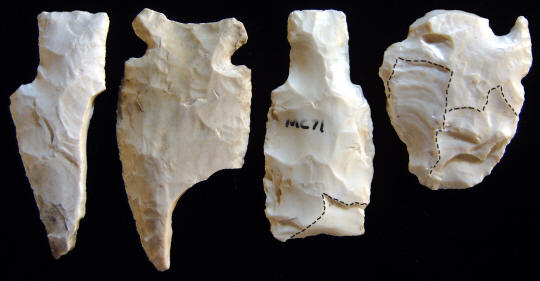
BURIN/SHEARING, BEND HINGE &
CRUSHING FRACTURES
ARCHAIC & WOODLAND POINTS
MADISON COUNTY, ILLINOIS
These four projectile
points all have what appear to be obvious use related impact fractures
on their tips. The two points on the left have large shearing type
fractures that resulted in burin break patterns. The Kramer point, third
from the left, has a large bend fracture that has a large hinge
termination. The Snyders point on the right has extensive use damage.
The tip and edges have crushing type fractures that resulted in large
flake scars that hinge on the face and step fracturing. One barb is
missing and a large part of the base is missing from a bend break. |
|
|
Impact experiments have shown that projectile points had a
high failure rate with nearly half or more breaking with their first
use. Point design and quality of material are two features that
influence the survival rate for a flaked stone projectile point. The
thickness to length ratio seems to be the most important design factor that determines a point's durability. The
Cheshire/Kelly study comments that, "A high thickness/length ratio increases
a point's lifespan." Frison (1986) suggests that a Clovis point might
need testing before confronting large Pleistocene mammals in order to
give the hunter a better chance of success. He writes that, "A finished
projectile point, however flawless its appearance, must have been
subjected to rigorous testing before use in order to detect flaws such
as crystal pockets or internal fractures that would appear during use." |
|
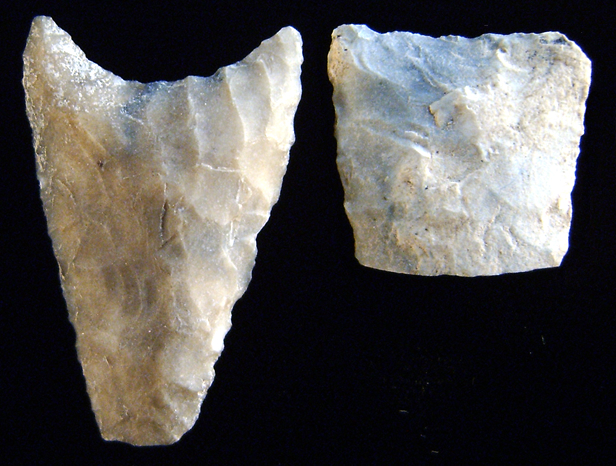
BEND-BREAK FRACTURES
TRIANGULAR ARROW POINTS
SWITZERLAND
Both of these Neolithic triangular arrow points from Switzerland have bend-break
type fracture patterns on their tips indicating possible use-wear
breaks. |
|
|
Projectile point impact studies are an important area of research.
There are so many different types of flaked stone projectile points, it would be
interesting to find out which ones were the best designs. Some types
definitely seem to have a better survival rate than others. Table Rock,
Haskett, and Agate Basin points might be good candidates as opposed to
Snyders, St. Charles, and Hardin Barbed points that seem to have more
snapped bases. |
|
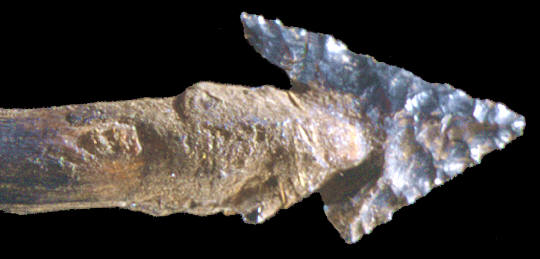
HAFTED CORNER-NOTCHED ARROW
POINT
SOUTHWESTERN UNITED STATES
This hafted arrow point has a broken barb that may or may not be
use-wear related. Some arrow point barbs are so delicate, many of
them must have broken accidentally. |
|
|
One of the most important factors for the survival
rate of any one type of projectile point is its resharpening
characteristics. Notched Points that tended to break at their "necks"
were discarded more often because re-basing is a more difficult
procedure. On-the-other-hand, lanceolate shaped points that have simple
but sturdy un-notched bases, like Haskett or Agate Basin points seem to
be more resharpening-friendly. The ability to salvage a point by
resharpening to increase its usable life-span is an important factor when
considering successful flaked stone projectile point design. |
|

ARROW POINTS WITH
BEND BREAK FRACTURES
AFRICA
These stemmed arrow points
from Africa all have bend-break fractures that probably result from
use-wear when they struck some type of object. Some of the barbs are
also damaged. |
|
|
Projectile point impact fractures represent
intriguing evidence of ancient hunting or warfare events. As prehistoric
populations increased, warfare would become more common but a greater
number of projectile points would have been used for hunting. The most
unique impact fractures are those found on the earliest Paleo-Indian
period dart and spear points. They were broken against the bodies of
mega fauna animals like mammoths and mastodons and a long list of other animals that have been extinct for thousands of years. |
|
"REFERENCES"
1979, Stanford, Dennis, "Bison Kill
By Ice Age Hunters," National Geographic, Vol. 155, No. 1, pp.
114-121.
1982, Huckell, Bruce B., "The Denver Elephant Project: A Report On
Experimentation With Thrusting Spears," Plains Anthropologist, Vol.
27, No. 97, August 1982, p. 217.
1982, Bradley, Bruce A., "Flaked Stone Technology And Typology,"
The Agate Basin Site, A Record Of The Paleoindian Occupation Of The
Northwestern High Plains, pp, 197-198.
1986, Frison, George C., "Mammoth hunting And Butchering From A
Perspective Of African Elephant Culling," The Colby Mammoth Site,
Taphonomy And Archaeology Of A Clovis Kill In Northern Wyoming, pp.
115-134.
1987, Bradley, Bruce A. & Frison, George C., "Projectile Points
And Specialized Bifaces From The Horner Sire," The Horner Site, The
Type Site Of The Cody Cultural Complex, pp. 216-217.
1997, Shea, John J., "Middle Paleolithic Spear Point Technology,"
Projectile Technology, pp. 79-106.
1999, Bement, Leland C., "Bison Hunting At Cooper Site,"
p. 104.
2002, Justice, Noel D., "Stone Age Spear And Arrow Points Of The
Southwestern United States," p. 97.
2006, Joseph Cheshier, Joseph & Kelly, Robert L., "Projectile
Point Shape And Durability: The Effect Of Thickness, Length," American
Antiquity, Vol. 71, No. 2, p. 354.
2006, Titmus, Gene L. & Woods, James C., "An Experimental Study
Of Projectile Point Fracture Patterns," Journal Of California And
Great Basin Anthropology, Vol. 8, No. 1, p. 43.
2006, Meltzer, David J., "Artifacts, Technological Organization,
And Mobility," Folsom, New Archaeological Investigations Of A Classic
Paleoindian Bison Kill, p. 285.
2009, Hashizume, Jun, "Paleoindian Projectile Point Breakage And Reshaping,"
Hell Gap, A Stratified Paleoindian Campsite At The Edge Of The
Rockies, p. 282.
2009, Sano, Katsuhiro, "Hunting Evidence From Stone Artifacts
From The Magdalenian Cave Site Bois Laiterie, Belgium: A fracture
Analysis," Quartar 56, pp. 67-86.
2012, Bower, Bruce, "Oldest Examples Of Hunting Weapon Uncovered
In South Africa," Science News, Dec. 15, 2012, Vol. 182, No.12,
p. 5.
|
|
RECENT
LISTINGS HOME
ORDERING |